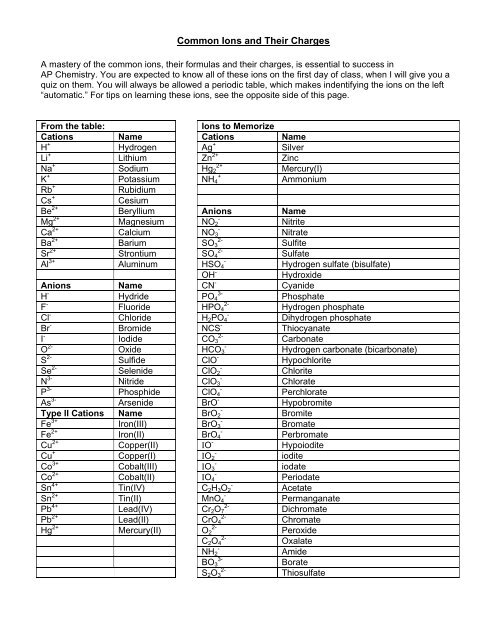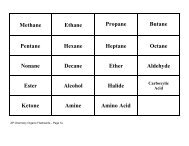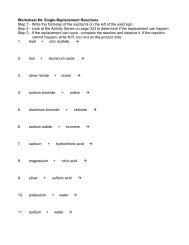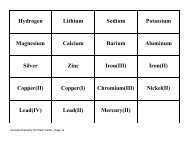Common Ions and Their Charges - ScienceGeek.net
Common Ions and Their Charges - ScienceGeek.net
Common Ions and Their Charges - ScienceGeek.net
Create successful ePaper yourself
Turn your PDF publications into a flip-book with our unique Google optimized e-Paper software.
<strong>Common</strong> <strong>Ions</strong> <strong>and</strong> <strong>Their</strong> <strong>Charges</strong><br />
A mastery of the common ions, their formulas <strong>and</strong> their charges, is essential to success in<br />
AP Chemistry. You are expected to know all of these ions on the first day of class, when I will give you a<br />
quiz on them. You will always be allowed a periodic table, which makes indentifying the ions on the left<br />
“automatic.” For tips on learning these ions, see the opposite side of this page.<br />
From the table: <strong>Ions</strong> to Memorize<br />
Cations Name Cations Name<br />
H + Hydrogen Ag + Silver<br />
Li + Lithium Zn 2+ Zinc<br />
Na + Sodium Hg2 2+ Mercury(I)<br />
K + Potassium NH4 + Ammonium<br />
Rb + Rubidium<br />
Cs + Cesium<br />
Be 2+ Beryllium Anions Name<br />
Mg 2+ Magnesium NO2 - Nitrite<br />
Ca 2+ Calcium NO3 - Nitrate<br />
Ba 2+ Barium SO3 2- Sulfite<br />
Sr 2+ Strontium SO4 2- Sulfate<br />
Al 3+ Aluminum HSO4 - Hydrogen sulfate (bisulfate)<br />
OH - Hydroxide<br />
Anions Name CN - Cyanide<br />
H - Hydride PO4 3- Phosphate<br />
F - Fluoride HPO4 2- Hydrogen phosphate<br />
Cl - Chloride H2PO4 - Dihydrogen phosphate<br />
Br - Bromide NCS - Thiocyanate<br />
I - Iodide CO3 2- Carbonate<br />
O 2- Oxide HCO3 - Hydrogen carbonate (bicarbonate)<br />
S 2- Sulfide ClO - Hypochlorite<br />
Se 2- Selenide ClO2 - Chlorite<br />
N 3- Nitride ClO3 - Chlorate<br />
P 3- Phosphide ClO4 - Perchlorate<br />
As 3- Arsenide BrO - Hypobromite<br />
Type II Cations Name BrO2 - Bromite<br />
Fe 3+ Iron(III) BrO3 - Bromate<br />
Fe 2+ Iron(II) BrO4 - Perbromate<br />
Cu 2+ Copper(II) IO - Hypoiodite<br />
Cu + Copper(I) IO2 - iodite<br />
Co 3+ Cobalt(III) IO3 - iodate<br />
Co 2+ Cobalt(II) IO4 - Periodate<br />
Sn 4+ Tin(IV) C2H3O2 - Acetate<br />
Sn 2+ Tin(II) MnO4 - Permanganate<br />
Pb 4+ Lead(IV) Cr2O7 2- Dichromate<br />
Pb 2+ Lead(II) CrO4 2- Chromate<br />
Hg 2+ Mercury(II) O2 2- Peroxide<br />
C2O4 2- Oxalate<br />
NH2 - Amide<br />
BO3 3- Borate<br />
S2O3 2- Thiosulfate
Tips for Learning the <strong>Ions</strong><br />
“From the Table”<br />
These are ions can be organized into two groups.<br />
1. <strong>Their</strong> place on the table suggests the charge on the ion, since the neutral atom gains or loses a<br />
predictable number of electrons in order to obtain a noble gas configuration. This was a focus in first<br />
year chemistry, so if you are unsure what this means, get help BEFORE the start of the year.<br />
a. All Group 1 Elements (alkali metals) lose one electron to form an ion with a 1+ charge<br />
b. All Group 2 Elements (alkaline earth metals) lose two electrons to form an ion with a 2+<br />
charge<br />
c. Group 13 metals like aluminum lose three electrons to form an ion with a 3+ charge<br />
d. All Group 17 Elements (halogens) gain one electron to form an ion with a 1- charge<br />
e. All Group 16 nonmetals gain two electrons to form an ion with a 2- charge<br />
f. All Group 15 nonmetals gain three electrons to form an ion with a 3- charge<br />
Notice that cations keep their name (sodium ion, calcium ion) while anions get an “-ide” ending<br />
(chloride ion, oxide ion).<br />
2. Metals that can form more than one ion will have their positive charge denoted by a roman numeral<br />
in parenthesis immediately next to the name of the<br />
Polyatomic Anions<br />
Most of the work on memorization occurs with these ions, but there are a number of patterns that can<br />
greatly reduce the amount of memorizing that one must do.<br />
1. “ate” anions have one more oxygen then the “ite” ion, but the same charge. If you memorize the<br />
“ate” ions, then you should be able to derive the formula for the “ite” ion <strong>and</strong> vice-versa.<br />
a. sulfate is SO4 2- , so sulfite has the same charge but one less oxygen (SO3 2- )<br />
b. nitrate is NO3 - , so nitrite has the same charge but one less oxygen (NO2 - )<br />
2. If you know that a sufate ion is SO4 2- then to get the formula for hydrogen sulfate ion, you add a<br />
hydrogen ion to the front of the formula. Since a hydrogen ion has a 1+ charge, the <strong>net</strong> charge on<br />
the new ion is less negative by one.<br />
a. Example:<br />
PO4 3- HPO4 2- H2PO4 -<br />
phosphate hydrogen phosphate dihydrogen phosphate<br />
3. Learn the hypochlorite chlorite chlorate perchlorate series, <strong>and</strong> you also know the series<br />
containing iodite/iodate as well as bromite/bromate.<br />
a. The relationship between the “ite” <strong>and</strong> “ate” ion is predictable, as always. Learn one <strong>and</strong> you<br />
know the other.<br />
b. The prefix “hypo” means “under” or “too little” (think “hypodermic”, “hypothermic” or<br />
“hypoglycemia”)<br />
i. Hypochlorite is “under” chlorite, meaning it has one less oxygen<br />
c. The prefix “hyper” means “above” or “too much” (think “hyperki<strong>net</strong>ic”)<br />
i. the prefix “per” is derived from “hyper” so perchlorate (hyperchlorate) has one more<br />
oxygen than chlorate.<br />
d. Notice how this sequence increases in oxygen while retaining the same charge:<br />
ClO - ClO2 - ClO3 - ClO4 -<br />
hypochlorite chlorite chlorate perchlorate





